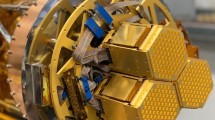Abstract
Families of cosmic inflation models predict a primordial gravitational-wave background that imprints B-mode polarization pattern in the cosmic microwave background (CMB). High-sensitivity instruments with wide frequency coverage and well-controlled systematic errors are needed to constrain the faint B-mode amplitude. We have developed antenna-coupled transition edge sensor arrays for high-sensitivity polarized CMB observations over a wide range of millimeter-wave bands. BICEP array, the latest phase of the BICEP/Keck experiment series, is a multi-receiver experiment designed to search for inflationary B-mode polarization to a precision \(\sigma ({r})\) between 0.002 and 0.004 after 3 full years of observations, depending on foreground complexity and the degree of lensing removal. We describe the electromagnetic design and measured performance of BICEP array’s low-frequency 40-GHz detector, their packaging in focal plane modules, and optical characterization including efficiency and beam matching between polarization pairs. We summarize the design and simulated optical performance, including an approach to improve the optical efficiency due to mismatch losses. We report the measured beam maps for a new broadband corrugation design to minimize beam differential ellipticity between polarization pairs caused by interactions with the module housing frame, which helps minimize polarized beam mismatch that converts CMB temperature to polarization (\(T \rightarrow P\)) anisotropy in CMB maps.







Similar content being viewed by others
References
Bicep/Keck Collaboration Phys, Rev. Lett. 121, 22 (2018). https://doi.org/10.1103/PhysRevLett.121.221301
A. Schillaci, et al., J. Low Temp. Phys., This Special Issue (2019)
H. Hui, et al., Proc. SPIE 10708, id. 1070807, (2018), https://doi.org/10.1117/12.2311725.
The Keck Array and BICEP2 Collaborations, The Astrophysical Journal, https://doi.org/10.1088/0004-637x/812/2/176(2015).
The Keck Array and BICEP2 Collaborations, arXiv e-prints (2019), arXiv:1904.01640
A. Soliman, et al., Proc. SPIE 10708, id. 107082G, (2018), https://doi.org/10.1117/12.2312942
The Keck Array and BICEP2 Collaborations, The Astrophysical Journal, https://doi.org/10.1088/0004-637X/806/2/206(2015)
H. Motevasselian, et al., Proc. IEEE 10708, Id. 6050307, (2011)
Acknowledgements
The BICEP/Keck project has been made possible through a series of grants from the National Science Foundation including 0742818, 0742592, 1044978, 1110087, 1145172, 1145143, 1145248, 1639040, 1638957, 1638978, 1638970, & 1726917 and by the Keck Foundation. The development of antenna-coupled detector technology was supported by the JPL Research and Technology Development Fund and NASA Grants 06-ARPA206-0040, 10-SAT10-0017, 12-SAT12-0031, 14-SAT14-0009 & 16-SAT16-0002. The development and testing of focal planes were supported by the Gordon and Betty Moore Foundation at Caltech. Readout electronics were supported by a Canada Foundation for Innovation grant to UBC. The computations in this paper were run on the Odyssey cluster supported by the FAS Science Division Research Computing Group at Harvard University. The analysis effort at Stanford and SLAC is partially supported by the US DoE Office of Science. We thank the staff of the US Antarctic Program and in particular the South Pole Station without whose help this research would not have been possible. Tireless administrative support was provided by Kathy Deniston, Sheri Stoll, Irene Coyle, Donna Hernandez, and Dana Volponi.
Author information
Authors and Affiliations
Corresponding author
Additional information
Publisher's Note
Springer Nature remains neutral with regard to jurisdictional claims in published maps and institutional affiliations.
Rights and permissions
About this article
Cite this article
Soliman, A., Ade, P.A.R., Ahmed, Z. et al. Optical Design and Characterization of 40-GHz Detector and Module for the BICEP Array. J Low Temp Phys 199, 1118–1126 (2020). https://doi.org/10.1007/s10909-019-02299-z
Received:
Accepted:
Published:
Issue Date:
DOI: https://doi.org/10.1007/s10909-019-02299-z




